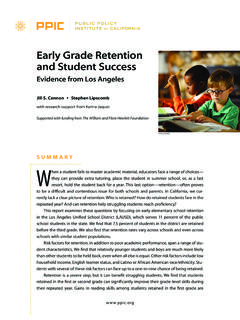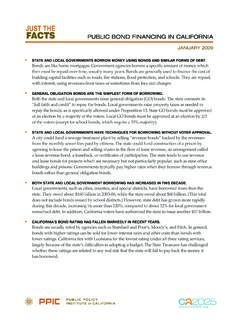Transcription of Foster Care in California
1 Foster care in California Achievements and Challenges Caroline Danielson Helen Lee with contributions from Daniel Krimm and Jay Liao Supported with funding from the Stuart Foundation AP Photo/BeBeto MAtthews Summary C. alifornia's Foster care system, responsible for about 63,000 children and youth who have been removed from their homes because of maltreatment or neglect, has made some remarkable advances in the last decade. Foster care is an exceptionally sensitive component of the state's child welfare system because it can mean the removal of a child from a family. So the goal of the Foster care system is to safely reunite children with their own families under improved conditions or to provide stable and beneficial home environ- ments elsewhere.
2 Data show that the state has made great progress in moving children out of Foster care . Since 2000, there has been a 45 percent drop in the share of California children in the system, a reduction achieved largely through shortening the time that most children spend in Foster care . In 31 of California 's 58 counties, the number of children in Foster care declined by 10 percent or more between 2000 and 2009 even as the popula- tion of children in the state increased from million to 10 million. The decline has been most pronounced among black children, who have long been overrepresented in the child welfare system. In 2000, percent of California 's black children were in Foster care , but only percent were in 2009. Furthermore, more Foster children are remaining in their first out-of-home placement, rather than going in and out of multiple placements, than at the beginning of the decade; and more children who entered Foster care later in the decade are eventually placed with relatives.
3 W w 2 Foster care in California These reductions, which far outpaced those across the rest of the country, may have resulted at least in part from a more intense focus by local and state policymakers on the problems of Foster care , which in turn led to innovations in child welfare policies and practices. The system still faces significant challenges. Payments to Foster families and other out-of- home care providers have not kept up with inflation. Despite the reduction in the proportion of black children in the system, they are still substantially overrepresented. There has been a worrisome increase in the share of children who enter Foster care more than once during their childhoods. And, despite the significant reductions, the number of children who age out of the system often facing uncertain futures with too little adult guidance has actu- ally risen since the beginning of the decade.
4 The changes we find and report here are measures of process, not of outcome. Confirma- tion that California children are in fact better off because they either entered Foster care or left it requires investigation into their circumstances. Toward that end, we recommend the gathering of broader data, including measures of the well-being of all children who come into contact with the child welfare system, but especially those who spend time in Foster care . Tracking children over time, as well as linking child welfare records with educational, health, parental employment, and criminal records collected by other government agen- cies, would yield valuable information about children's well-being. It would also pave the way for policy and practice innovations that could extend the noteworthy changes that have occurred in this decade.
5 Please visit the report's publication page to find related resources. w w Foster care in California 3. Introduction The child welfare system in California is a fundamental part of the state's social safety net, charged with the task of protecting children from harm and furthering their well-being. Child welfare departments in the state's 58. counties investigate hundreds of thousands of reports of suspected abuse or neglect annually. Responses by county caseworkers and courts to child maltreatment defined as the neglect or abuse of a person under age 18 are tailored to the circumstances of the child and family and to the requirements of the Most children whose maltreat- ment report has been substantiated remain in their homes with their families, with support services provided to istocK MirosLAv GeorGiJevic them.
6 But roughly one in three children with a substanti- More than 30,000 children enter Foster care in California each year, ated report is placed in temporary, out-of-home Foster care . but even more leave. In the 2008 2009 fiscal year, close to 32,000 California children were placed outside their homes because juvenile dependency courts deemed that the child's removal and In this report, we focus specifically on describing and intervention services to the family were necessary before discussing issues central to Foster care in California and the child could safely return home. The Foster care caseload on the significant advances that have occurred since 2000. thus encompasses the most severe and difficult cases of Foster care serves a relatively small share of children and maltreatment and neglect.
7 Families who come into contact with the child welfare sys- The goals of those who administer Foster care are to tem in any given year, but the costs to support out-of-home place children in the most family-like settings as pos- care for children are among the largest in the child welfare sible, to keep their stays in Foster care short, and, as much system. Specifically, California and its counties (which as possible, to return children to their own families. If administer most of the direct services to children) spent children cannot safely reunify with their parents, the about $ billion on child welfare services in 2008 2009. emphasis shifts to creating a permanent placement with a Foster care support payments make up approximately one- legal guardian or adoptive family.
8 Foster care is a dynamic, quarter of that; allocations for ongoing support payments high-turnover system: Tens of thousands of children enter to adoptive parents and to guardians cost nearly an addi- in any given year, but the state also reunites about the same tional $1 billion (Mecca 2008, Reed and Karpilow 2009). number of children with their families or places them The Foster care system has suffered from perennial with adoptive families or legal guardians. However, each challenges (County Welfare Directors' Association 2007, year, several thousand children also leave Foster care only Little Hoover Commission 2003). These included, in because they age out of eligibility, an outcome that makes previous decades, a higher share of children in Foster care them the focus of great concern.
9 A wealth of evidence in California than in the rest of the nation and persistent indicates that young adults who age out of Foster care are racial and ethnic disparities, particularly for black chil- at significant risk of poor outcomes in education, employ- dren. Counties also have had to deal with a shortage of ment, health, homelessness, and crime. Foster family homes. w w 4 Foster care in California But since the beginning of the decade, there have been This report offers both a detailed examination of the notable changes in Foster care policy, process, and practice. transformation that has occurred in the Foster care system Policymakers have intensified their focus on Foster care since 2000 and its continuing challenges.
10 We identify key issues: Most recently, in 2009, the Blue Ribbon Commission processes underlying the changes, so that stakeholders can on Children in Foster care released recommendations to plan how best to sustain efforts that promote success and improve the courts' role in Foster care ( California Blue Rib- policymakers can focus scarce resources on the system's bon Commission on Children in Foster care 2009). Earlier, most pressing problems. in 2006, the legislature created the Child Welfare Council, a permanent advisory group developing recommendations for improved collaboration and coordination across the System Overview courts, agencies, and departments that serve children (Child Welfare Council 2008). The introduction in 2000 of a state A child's first point of contact with child welfare services assistance program, the Kinship Guardianship Assistance in a county is typically through the 24-hour emergency Payment (Kin-GAP) program, was an initiative to increase response hotline that all counties maintain.














